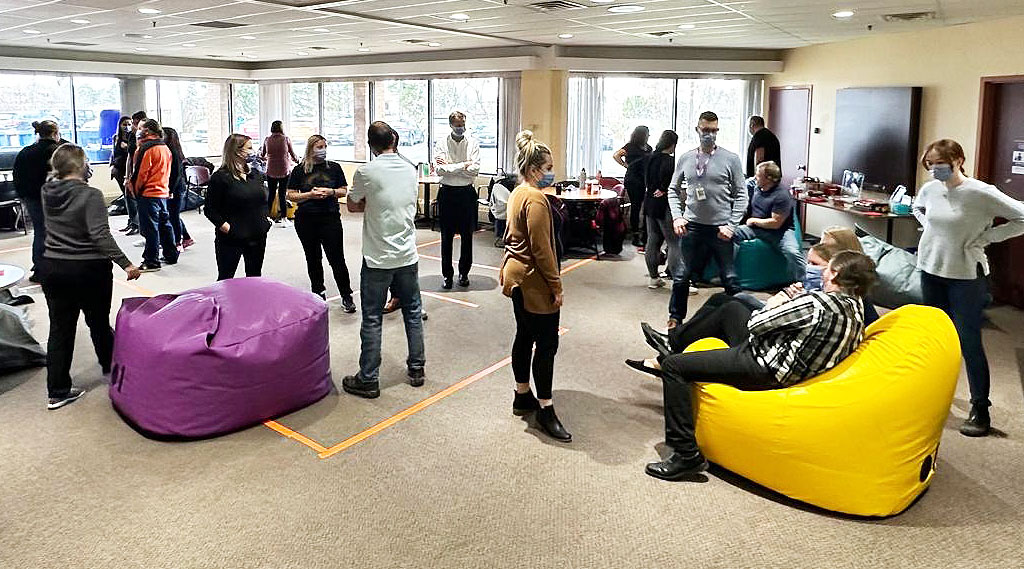Children’s Hospital ofEastern Ontario
Successful Implementation of Safety Pods at CHEO:
A Step Towards Trauma-Informed Care and Restraint Reduction
Client: Children’s Hospital of Eastern Ontario
Product: Standard Safety Pod

In its ongoing commitment to improving patient care and reducing the use of restrictive practices, the Children’s Hospital of Eastern Ontario (CHEO) has successfully introduced Safety Pods to its Inpatient Psychiatry unit. This initiative, which aligns with CHEO’s dedication to restraint reduction and trauma-informed care, represents a significant shift in how the hospital approaches the management of distressed children and youth in its care.
Addressing the Impact of Restraints
Restraints, though sometimes necessary to prevent imminent harm to a patient or others, often come with unintended consequences. These can include psychological trauma, physical harm, and the deterioration of the therapeutic relationship between staff and patients. This is particularly concerning in psychiatric settings where young patients, already dealing with significant emotional or behavioural challenges, may be further traumatized by restrictive interventions.
Traditionally, ground or prone restraints have been used to physically control patients who are in acute distress. While effective in some situations, these methods have been linked to physical injuries, increased anxiety, and long-term psychological effects. Recognizing these risks, CHEO has taken a positive step by introducing the UK-designed Safety Pods as part of its restraint reduction strategy.
Traditionally, ground or prone restraints have been used to physically control patients who are in acute distress. While effective in some situations, these methods have been linked to physical injuries, increased anxiety, and long-term psychological effects. Recognizing these risks, CHEO has taken a positive step by introducing the UK-designed Safety Pods as part of its restraint reduction strategy.
The Role of Safety Pods
The Safety Pod is a large, supportive, beanbag-like structures that provide a safer, more comfortable, and trauma-informed alternative to traditional restraints. Unlike conventional restraints that force children and youth into physically restrictive positions, the Safety Pods allow patients to remain seated and upright, offering a less invasive and more supportive approach during moments of crisis.
The Safety Pod is designed to provide stability and comfort, without compromising safety. They help create a controlled, calming environment while reducing the need for ground or prone restraints. This approach minimizes the physical and psychological risks associated with restraint use, offering a more therapeutic and compassionate alternative for both patients and staff.
Key Benefits of the Safety Pods
Since their implementation, the Safety Pods have demonstrated a range of benefits, both for patients and staff, as well as for the broader therapeutic environment as captured in this feedback:
- Reduced Trauma: The use of Safety Pods has led to less traumatic interventions. Because the pod allows patients to remain seated in a safe, supportive manner, it helps to avoid the distressing experience of being physically restrained on the floor or in prone positions
- Greater De-escalation Opportunities: Staff have reported an increased ability to verbally de-escalate situations, as Safety Pods allow for a more controlled and less intimidating approach. This shift enhances the therapeutic relationship and promotes a sense of trust between staff and patients
- Lower Risk of Injury: The supportive structure of Safety Pods reduces the risk of injury for both patients and staff. By replacing more physically demanding restraint techniques, the pods help protect everyone involved from harm
- Enhanced Staff Safety: Safety Pods also reduce the physical demands on staff, decreasing the likelihood of injuries during interventions. This makes the work environment safer for caregivers and allows them to focus on providing supportive care
- Maintained Dignity and Comfort: One of the most significant advantages of Safety Pods is the enhanced dignity they provide for patients. Rather than being physically restrained, patients are given a safer, more comfortable space to manage their distress. The pods can be used as a preventive measure, allowing patients to retreat to a safe space before the situation escalates
- Decreased Stimulation: Safety Pods also help to reduce overstimulation in patients who are particularly sensitive to their environment. With their calming design, the pods help patients feel more at ease, which is critical in psychiatric care
- Independent Access for Comfort and De-escalation: In a notable shift from traditional restraint practices, the Safety Pods are available for patients to access at any time, regardless of whether they are in a restraint situation. This gives patients a greater sense of autonomy and control over their own care, enabling them to use the pods proactively for comfort and de-escalation
Supporting Trauma-Informed Care
The introduction of The Safety Pod at CHEO is a clear example of the hospital’s commitment to trauma-informed care, which focuses on creating a safe, supportive environment that recognizes the impact of trauma on patients’ well-being. By offering a more compassionate approach to restraint, the hospital not only reduces the risks of physical and psychological harm but also prioritizes the dignity and therapeutic relationship with its young patients.
Safety Pods have also played a key role in reducing the overall use of restraints in the Inpatient Psychiatry unit. As a result, there has been a noticeable decrease in the amount of time patients spend in restraints, as well as a reduction in the use of ground and mechanical restraints. These positive outcomes contribute to maintaining the therapeutic relationship, which is vital in supporting long-term recovery and emotional well-being.
Conclusion
CHEO’s implementation of Safety Pods represents a significant advancement in the care of children and youth in psychiatric settings. By providing a safer, more supportive alternative to traditional restraint methods, the hospital is reducing the risks of harm, improving the therapeutic environment, and reinforcing its commitment to trauma-informed care. The positive outcomes observed since the introduction of Safety Pods highlight the importance of innovative approaches to mental health care and the potential for creating safer, more compassionate care environments for vulnerable populations.

